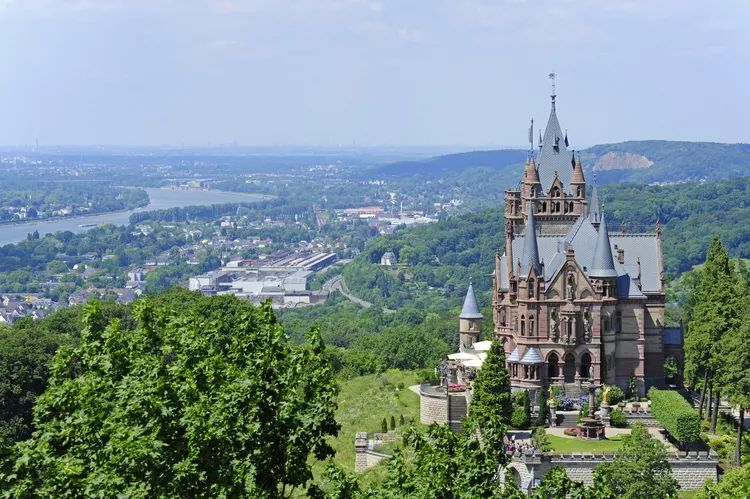Summary
Driving from Berlin to Belgium, a short detour will bring you to a castle just a short distance from Bonn and Cologne. Drachenfels (Dragon’s Rock) refers to the medieval ruins at the top of the peak, but there is also a modern and impressive interpretation of a castle three-quarters of the way up the slope.
History of Drachenfels
Siegfried, the hero of the Nibelungenlied, is said to have slayed the dragon Fafnir here and bathed in its blood to become invulnerable. The history alone is an intriguing reason to visit.
More down to earth, the castle is located in the seven hills of Siebengebirge between Königswinter and Bad Honnef. Drachenfels is a hill within the Siebengebirge uplands, overlooking the Rhine from a height of 1,053 feet (321 meters). The rock of the mountain was formed by an ancient volcano and was used as a trachyte quarry in Roman times. The stone from the site was used to build the iconic Cologne Cathedral.
The fortress’ history began as a defense against attackers to the south. Arnold I, the Cologne archbishop, ordered its construction from 1138 to 1167. However, the fortress’ development was undone in 1634 when an archbishop dismantled it during the Thirty Years War. Erosion continued this work, and today, little more than rubble remains of the earlier structure atop the hill.
That doesn’t signify the end of Drachenfels. It remained a popular destination for Rhine romantics, with notable visits from elites like Lord Byron. Today’s visitors often come for the picturesque Schloss Drachenburg, a neogothic castle from 1882 commissioned by Baron Stephan von Sarter. The castle has changed hands multiple times, each owner leaving their eccentric imprint, from a potential Zeppelin landing pad to amusement parks and 1970s disco parties.
Currently, it is owned by the state of North Rhine-Westphalia and is open for public visiting. Its elaborate rooms and regal grounds offer stunning views of the river and valley below, and on a clear day, visitors can see all the way to the towers of Cologne’s Cathedral.
:max_bytes(150000):strip_icc():format(webp)/drachenburg-castle-in-autumn--koenigswinter--rhine-valley--north-rhine-westphalia--germany-979237226-5c26d9fac9e77c0001b19742.jpg)
Visiting Schloss Drachenburg
The castle’s modern origins (for European standards) mean that little is genuinely antique about the Schloss, but it remains a worthwhile destination. The nod to multiple early German architectural styles serves as a tribute, while showcasing a grand example of 19th-century opulence. This magnificence attracts over 120,000 visitors each year.
A bistro, restaurant, and shop are available on the grounds, ensuring that all visitors have options. For those who prefer not to walk up the steep hill, a historic funicular is available to take visitors from the bottom to the top.
How to Get to Drachenfels
Address: Drachenfelsstrasse 118, 53639 Königswinter, Germany
By Train:
Cologne (Köln) – Koblenz route (RE8 or RB27), stopping at Königswinter every 30 minutes.
By Car:
From Cologne (Köln): Take A555 to Bonn, then A565 Bonn, Beuel Nord, and continue on A59 towards Königswinter, followed by B42.
- From Ruhr Area: Take A3, then A59, and continue on B42 to Königswinter.
- From Frankfurt: Follow A3 until exit Siebengebirge/Ittenbach, then follow the street to Königswinter.
- From Koblenz: Take B42 following the Rhine until Königswinter, or choose B9 / Bonn and the Rhine Ferry to Königswinter.
By Boat
Multiple Rhine river cruises stop at Drachenfels.
Admission to Schloss Drachenburg
- Adults: 7 Euro
- Kids/Discount (student, elderly, disabled): 5 Euro
- Family Ticket: 17 Euro




